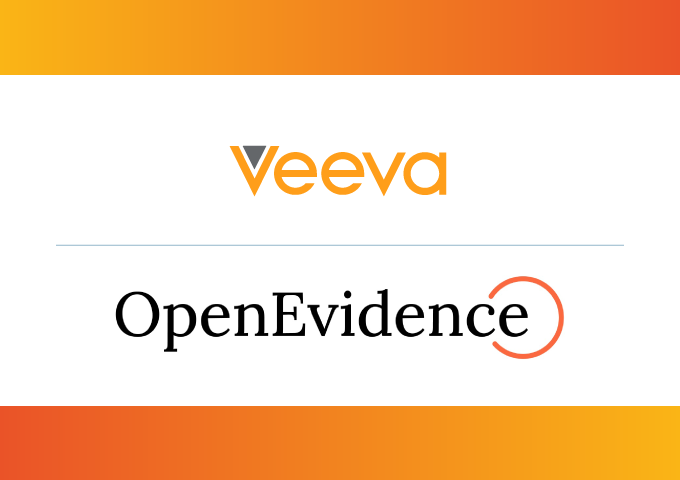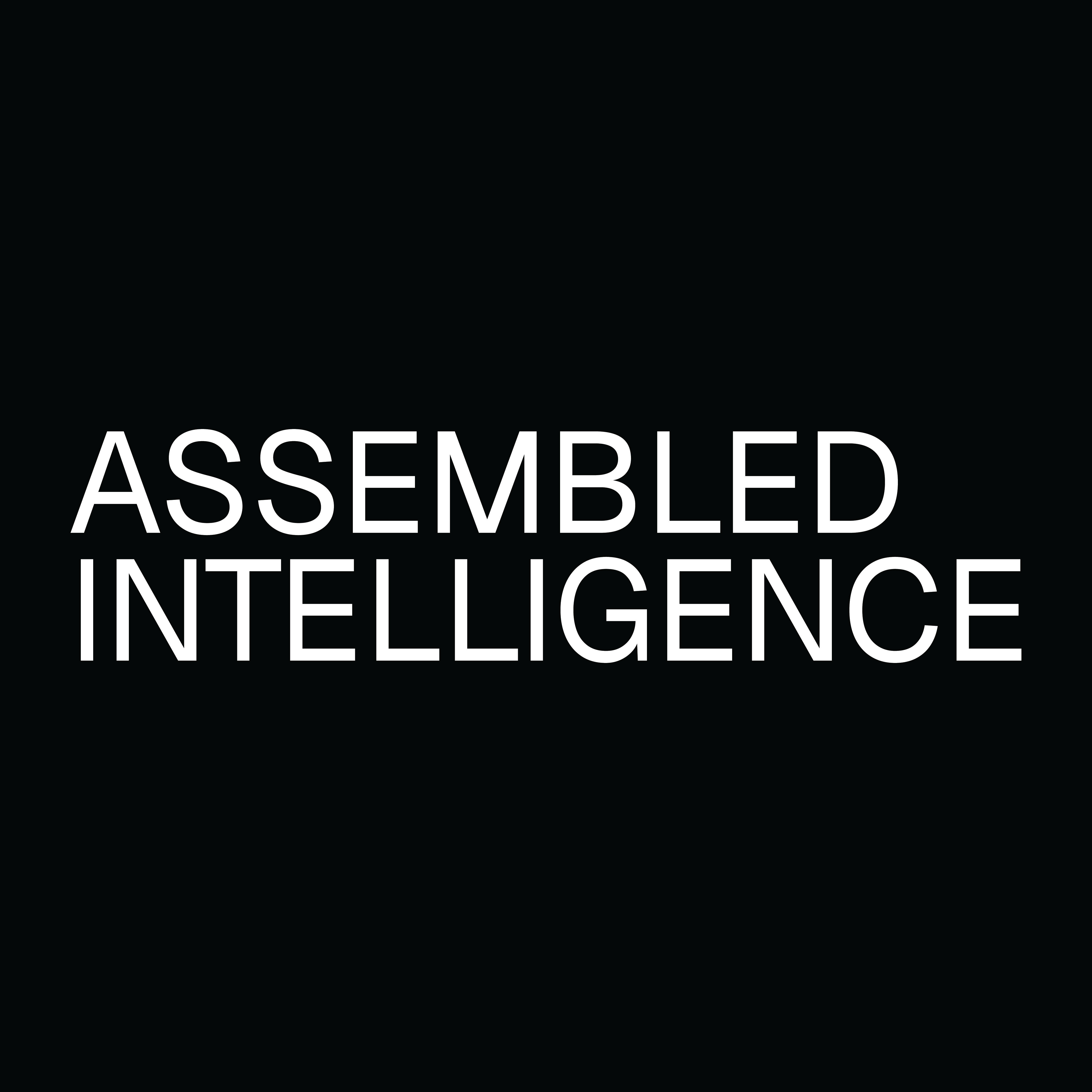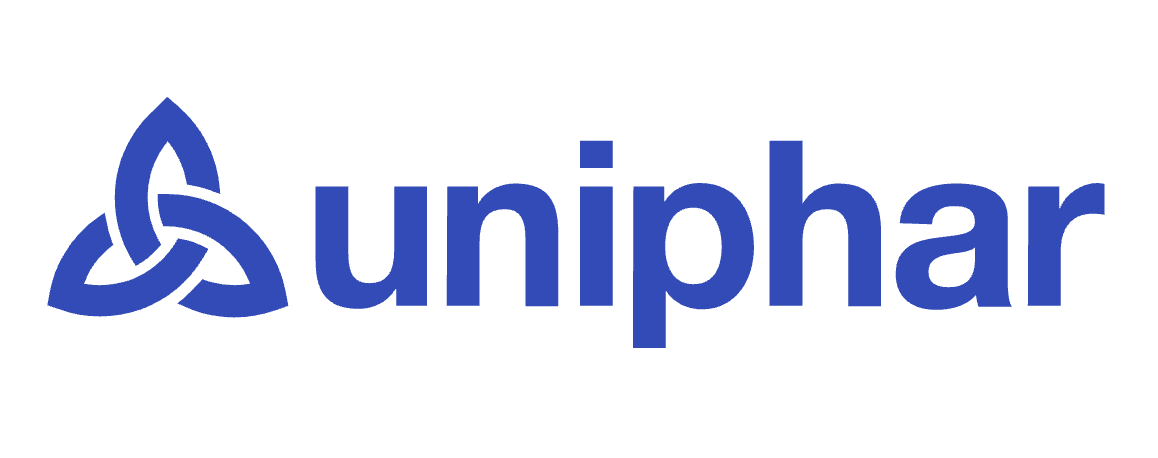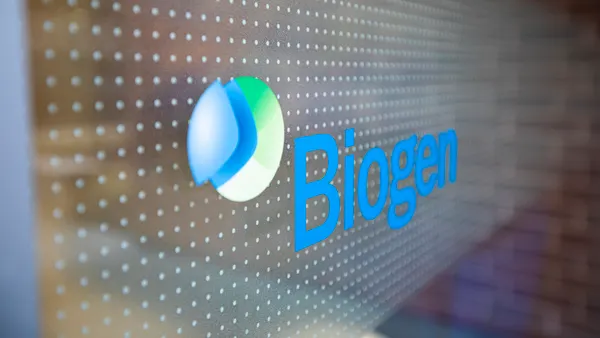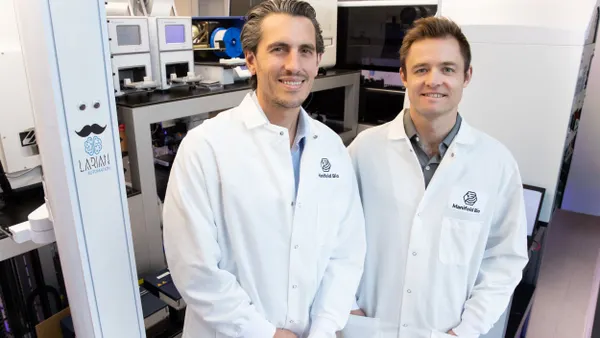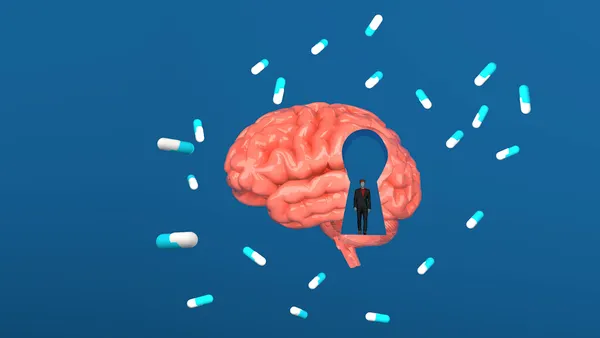Nanotechnology It’s a Small World BY DENISE MYSHKO The biggest thing right now in the industry just may be the smallest. A growing interest in nanotechnology – the ability to work at the atomic and molecular levels – is spurring R&D investments in pharmaceutical discovery, diagnostics, and drug delivery. In the long term, this research could lead to some fantastic revolutions in healthcare. I magine being able to use a single molecule as a vehicle to deliver cancer therapeutics, insulin-producing cells, and even anesthesia. But this is not just any molecule. This is the buckyball, a soccer-ball shaped cluster of 60 carbon atoms bonded together to form a hollow sphere. Sound like science fiction? Think again. The buckyball – also known as buckminsterfullerene named after U.S. architect Richard Buckminster Fuller because of the resemblance of the structure to the geodesic dome he invented – is the subject of several research projects. One company has even created a new type of liposome that uses the buckyball structure that has the potential to deliver large drugs and those that are not water-soluble. Because the pores of the sphere are so small, a person’s antibodies wouldn’t be able to penetrate the sphere, which would be important for delivering insulin. A growing interest in nanotechnology is spurring investment in the research of buckyballs and other projects that are small in scale, but big in potential. How small? Try 1/100,000 the width of a human hair. The prefix “nano” represents one-billionth of a unit. For example, a nanosecond is one-billionth of a second. How big? Estimates range from $500 million by 2007 to $1 trillion by 2015 – either way this is not small change. limitless Possibilities Scientists and engineers anticipate that nanoscale work will enable the development of materials and systems with dramatic new properties relevant to virtually every sector of the economy, such as medicine, telecommunications, computers, textiles, and even homeland security. Last year, nanotechnology received a lot of press surrounding a brand of stain-repellent and wrinkle-free fabric by Nano-Tex. The company’s NanoCare product allows enhancements to permanently attach to the fiber of fabrics at the nano or sub-micron level. Gap and Eddie Bauer are among the companies that use such technology in some of their clothes. In healthcare, researchers say the possibilities of nanotechnology are as expansive as our imagination. Some speculate this research could produce: a radiotransmitter small enough to put into a cell; high concentrate hydrogen peroxide for teeth whitening that consumers can mix up in the bathroom; acoustical devices to measure and record the noise a heart makes; bioimplantable sensors that bridge the gap between electronic and neurological circuitry; more durable rejection-resistant artificial tissues and organs; vision and hearing aids; and sensor systems that detect emerging disease in the body. In the pharma industry, there is potential to provide new formulations and routes of drug delivery and more rapid sequencing for drug discovery. In fact, companies such Bristol-Myers Squibb, Merck, and Janssen Pharmaceutica are investing research dollars in nanotechnology though various partnerships. “The concept of miniaturization has tremendous application in medicine,” says Scott H. Gillis, president of Nucryst Pharmaceuticals. “Think about surgery, which at one time was very destructive since large incisions had to be made. Now many surgeries are done with minimally invasive techniques such as with laparoscopes. As technology makes things smaller and smaller, procedures will be done with much less damage to the human body. I envision that miniaturization of medicine will help physicians to help patients.” The potential of research into the small is huge, so huge in fact that in early December 2003, President George W. Bush signed legislation to fund nanotechnology research and development. The 21st Century Nanotechnology Research and Development Act provides $3.7 billion in spending over four years beginning in fiscal year 2005. The measure puts into law programs supported by the National Nanotechnology Initiative (NNI), one of the President’s multi-agency R&D priorities. Even before the passage of this legislation, nanotech research was a priority of the current White House; overall funding for nanotechnology research has increased 83% since 2001. The President’s 2004 budget provides $849 million to NNI, a 9.5% increase over 2003. The NNI strategy for 2004 involves further investment in fundamental research across the range of scientific and engineering disciplines through investments in investigator-led activities at colleges and universities, centers of excellence, and supporting infrastructures. “This bill is historic legislation because it establishes an ongoing national commitment,” says Rich Shanley, a partner at Deloitte & Touche. “In the past, funding was done year by year. This bill acknowledges the idea that there is interest in nanotechnology around the world.” “Our government is very concerned about where we shake out in terms of nanotech investment,” says Ed Moran, director of product innovation at Deloitte & Touche. “The Japanese, the Europeans, and it’s even rumored that the Chinese are spending a tremendous amount of money on nanotech. Nanotech is in the early stages and if U.S. companies can lock up intellectual property at this point, this very basic technology could be very valuable.” As of 2002, U.S. organizations held more than 6,000 patents involving nanotechnology, which was about 75% of total nanotechnology patents worldwide, according to the National Science Foundation (NSF). The reformulation of existing drugs at the nanoscale will allow drug manufacturers to extend exclusivity, says Steve Maebius, a partner in the law firm of Foley & Lardner. “Many companies are looking at nanotech as a way to make an improved version of a drug so that when that drug is about to go off patent, they can get a fresh period of exclusivity,” he says. “This could be as much as 20 years for an extension resulting from a new patent on the nanotech version of the drug.” As diverse as the opportunities for nanotechnology, nanobiotechnology, and nanomedicine are, so are the types of tools and the areas of research. Some current research includes work with: fullerenes (the buckyballs); dendrimers (protein-sized molecules that can be used to deliver therapeutic agents); nanoshells (minuscule beads coated with gold that are designed to absorb light) and nanotubes (silica-gold nanoshells); and quantum dots (nanoparticles with special luminescent properties to identify cellular structures). The technology to make small particles has been around for a long time, says Rudi E. Moerck, Ph.D., president of Altair Nanotechnologies Inc. “But now we have new and better analytical tools and manufacturing techniques,” he says. “There are now improved electron microscopes and other instruments that allow a detailed view of nanostructured materials. We have new ways of measuring the surface area and structure of molecules that we didn’t have before. These techniques allow us to make customized particles and shapes, and they allow us to make correlations between the shape, size, and any medical benefit that we might want to achieve.” “Nanotechnology is a set of enabling technologies,” Mr. Moran says. “It’s not a science in and of itself. It’s an unprecedented move to have a number of disciplines work together. Nanotech is cross disciplinary.” Mr. Moran says nanotechnology is not science fiction, yet there has been much hype – and a lot of misinformation. In December 2002, Red Herring magazine predicted a backlash against nanotechnology when Michael Crichton’s book “Prey” came out. In that book, “nanobots,” self-replicating nanotechnology machines, turn on their creators. More recently, in January a group of British scientists warned that nanoparticules deposited in the nose could migrate to the brain and move from the lungs to the blood stream. “We don’t believe that size in and of itself has anything to do with toxicity,” says Russ Lebovitz, M.D., Ph.D., VP of research and business development at C Sixty. “We could design molecules that are harmful, but that would be because of the way they were built, not because they were small. There’s an absolute intent of creating hysteria. Anytime someone says anything nano causes damage, that’s the hype machine talking.” The Market Potential Estimates about the market potential are wide ranging. According to a NSF report issued in November 2003, revenue from new technologies and products resulting from nanotechnology throughout several industries – including aerospace, electronics, chemicals, and other materials beyond chemistry, tools, and pharmaceuticals – could reach $1 trillion a year worldwide by 2015. Pharmaceutical products alone could be valued at $180 billion a year. According to Business Communications Company (BCC), the worldwide market for nanoscale devices and molecular modeling is expected to increase at an average annual growth rate of 27.5%, from $406 million in 2002 to $1.37 billion in 2007. Growth in the nanotech markets will be driven by increasing efforts to improve drug delivery and bioavailability, especially for drugs with poor water solubility or those that have significant side effects. But other analysts predict more moderate, yet still significant, potential. Girish Solanki, industry manager for the Technical Insights division at Frost & Sullivan, says a more realistic value is about $500 million by 2007. “The NSF number is a top-down estimate, but if we’re to consider a bottom-up approach, I think a conservative valuation is likely to be in the region of $500 million by 2007,” he says. “This is the value of the nanotechnology tools and processes that are actually used, not the value of end-user products. There are a number of other technologies that could be used that contribute to the product to make it what it is, and our estimates take cognizance of that.” Michael Steiner, Ph.D., director of Bain & Company and global leader of Bain’s healthcare practice, estimates that the value of the nanotechnology and nanobiology market will be $1 billion by 2005 and $18 billion by 2015. “One of the biggest challenges for companies developing the technology is focusing on real commercial opportunity and developing market disciplines,” says David J. Bishop, Ph.D., president of the New Jersey Nanotechnology Consortium. “There won’t be buy-in just because the technology is cool and neat. There will be buy-in because nanotechnology is an optimal solution to a real-world problem. A nano solution will not only have to be far better but far cheaper.” Nano in Application Researchers at BCC say nanoscale will eventually be employed as drugs or for drug delivery; in assays used for medical diagnosis, drug discovery, or basic biological research; as contrast agents for MRI imaging; and in imaging instruments, such as X-ray devices. Mr. Maebius cites Elan’s nanocrystalline drug formulations, which were developed by NanoSystems (a company now owned by Elan), as an example of how nanotechnology is currently being applied. The company’s NanoCrystal technology may enhance the clinical performance of poorly water-soluble drugs by transforming them into nanometer-sized particles. The drug in nano form can be incorporated into common dosage forms, including tablets, capsules, inhalation devices, and sterile forms of injection. Wyeth’s Rapamune, the first product approved using NanoCrystal technology, was approved in August 2000 to prevent organ rejection in kidney transplant patients. More recently, Merck’s Emend, approved in March 2003 to prevent nausea and vomiting during cancer chemotherapy, also uses the NanoCrystal system. Bristol-Myers Squibb, in September 2003, and Janssen Pharmaceutica, in October 2003, signed research agreements with NanoSystems to apply NanoCrystal to products that are poorly water-soluble. Bristol-Myers Squibb also has a license agreement with Flamel Technologies to develop and market Basulin, a controlled-release, unmodified human insulin, to be developed as a once-daily injection for patients with diabetes. Basulin, which is in Phase II development, is delivered via Medusa, a nanoparticulate technology that was developed by Flamel. Flamel has customized Medusa nanoparticles to control the release of native proteins over a long period of time with high bioavailability and efficacy. Medusa allows the development of second-generation protein drugs with better performance, reduced side effects, and improved compliance. Another company using nanoscale research to develop therapeutics and drug-delivery systems is C Sixty. The company has a research and license agreement with Merck to develop drugs based on C Sixty’s fullerene antioxidants, or buckyballs. “The fullerenes themselves are not biologically accessible,” Dr. Lebovitz says. “They can’t get into the blood or into cells. Our intellectual property and our knowledge of fullerene chemistry allows us to modify the native fullerenes so they can be biomedically accessible, and we can modify them in ways that give them specific targeting and specific functioning in the body.” Fullerenes, he says, have extraordinary electrochemical properties and an unusual ability to hold extra electrons floating around in a cell. “This is extremely important because it turns out that there are a number of disease processes related to something called free radicals,” Dr. Lebovitz says. Free radicals are small molecules related to oxygen. They turn harmless oxygen into properties that can be very damaging to the cell. Some theorize this is probably one of the major causes of cell damage in a variety of diseases. C Sixty is conducting preclinical research of modified fullerenes for CNS degenerative diseases, such as Parkinson’s, ALS, Alzheimer’s, and stroke, as well as some cardiovascular conditions. “We think these are diseases for which nothing works well right now and where the large component of the damage is caused by free radicals,” Dr. Lebovitz says. On the drug-delivery side, C Sixty also is working on research that allows the company to build a new generation of liposomes. Dr. Lebovitz says the use of liposomes, which are artificial membranes, may be limited because of problems related to stability, the inability to deliver to the right site, and the inability to release the drug when it gets to the right site. C Sixty has created what Dr. Lebovitz calls “buckysomes,” a new generation of liposomes that incorporate fullerenes to deliver drugs that are not water-soluble, that tend to be very large, and that are very hard to get into the body. C Sixty’s buckysomes appear to have much more flexibility in incorporating a wider range of drugs, as well as larger drugs, and delivering and releasing them more effectively. The company is studying these to deliver cancer and anesthesia therapeutics. Another company developing a therapeutic based on nanotechnology is Nucryst Pharmaceuticals, a subsidiary of The Westaim Corp. Nucryst recently began a Phase II human clinical trial of a topical cream formulation of its nanocrystalline silver. The investigational drug, NPI 32101, is being studied for atopic dermatitis, a form of eczema, and other skin conditions and represents a biological application of nanotechnology. “The process that we use is physical vapor deposition; this is sometimes referred to as sputtering,” Mr. Gillis says. “We developed a very large vacuum chamber and into this chamber, we place pure silver. Then we use a series of different gases and energy levels to bombard the silver with positiv ions, breaking off pieces of silver atom by atom. We then recombine the silver atoms in a novel nanocrystalline structure.” Silver has been valued for centuries for its medicinal properties. From ancient Greece to the American settlers, silver was used as a preservative for drinking water and other liquid storage. Decades ago, doctors would apply a thin layer of silver to large wounds to prevent infection and promote healing. Nucryst’s silver nanocrystalline technology decreases the particle size, thus changing the physical and chemical properties. As the proportion of atoms on the surface increases, the result is a more powerful compound than conventional silver treatments. In vitro tests have demonstrated that active silver clusters of ions begin providing antimicrobial activity immediately and kill many organisms in 30 minutes, faster than other forms of silver. “The new silver has enhanced properties,” Mr. Gillis says. “For example, in the laboratory we have been able to kill bacteria more quickly using our silver compared with naturally occurring silver. We’ve also been able to reduce inflammation more significantly and more rapidly than naturally occurring silver.” Mr. Gillis says the company also is conducting preclinical studies on the use of nano crystalline silver inhaled into the lungs for the treatment of serious lung infection or lung inflammation. In the future, the company plans to conduct research on the nanocrystalline structures of other metals, including gold, which is well-known as a treatment for arthritis, and platinum, which is a well-known treatment for cancer, to determine if the behavior and performance of these metals also can be enhanced. Altair is another company developing novel new drugs using nanotechnology. The company has developed its lanthanum-based inorganic active pharmaceutical called RenaZorb. The product, for which preclinical work has been completed in animal models, provides phosphate control in kidney dialysis patients. Phosphate in blood serum builds up in patients with end-stage renal disease (ESRD) because the patient’s kidneys cannot efficiently remove it. This imbalance has been traditionally treated using binders that react with phosphate in the digestive system forming complexes that do not allow the phosphate to be absorbed into the blood. Patient compliance and the discovery that some treatments create additional undesirable side effects, such as aluminum dementia and hypercalcemia, has led to the development of noncalcium-based systems, including lanthanum-based systems. Altair’s lanthanum-based drug is a nanomaterial with high surface area and is highly active but exhibits low intestinal solubility. The relatively high phosphate binding capacity and lower dosage requirements appear to be better than existing drugs. Lower doses possibly may minimize side effects and simultaneously improve patient compliance. Altair also has developed unique micron-size structures capable of carrying active pharmaceutical ingredients (API), biocides, fungicides, or narcotics on either the interior or exterior surfaces of the structures. The micron-sized spheres, called TiNano Spheres, are based on Altair’s patented “growth-in-film” nano-technology and consist of hundreds of nanoparticles bound together in spherical and near-spherical shapes. The nanoparticles have a very high surface area and, when coated with an API, deliver a very large amount of drug to a biosystem interface. This larger interface could improve solubility and/or reaction rates. “The TiNano Spheres are Wiffleball-like structures and are made of metal oxides such as titanium dioxide,” Dr. Moerck says. “The balls are porous and can be made in various sizes – from nano to micron. The pores can be customized and that would determine the sustained-release ability of the drug in the spheres. TiNano Sphere can be filled with narcotics and since the spheres are difficult to mechanically ‘crush,’ this drug-delivery system may represent a unique, nondefeatable way to deliver narcotic drugs that have potential for abuse.” A longer-term product is Integrated Nano-Technologies’ NanoSyringe. The company’s core product development is centered around a patented technology for chemically synthesizing complex electronic circuits and devices. Using DNA as a framework, conductors, semiconductors, plastics, and other materials can be attached to specific locations on a DNA strand to form wires, transistors, diodes, and other electronic components. This process can be carried out with a high degree of precision with respect to device, element size, and placement. The technology also allows for the incorporation of biological materials such as proteins and antibodies. The NanoSyringe is a site-specific delivery system, which will allow for delivery of therapeutic agents directly to specific cells. It will be most applicable in the treatment of cancers, drug-resistant infections, and gene therapy. “Basically, we’re using DNA as a scaffold to build a drug-delivery system,” says D. Michael Connolly, Ph.D., CEO, president, and founder of Integrated Nano-Technologies (INT). “The NanoSyringe encapsulates a drug in a DNA shell that’s coated with plastic. Inside is an electronic circuit that is used to fire the drug from the device into the cell.” In addition, INT has developed BioDetect, an electronic-based, field-portable DNA detection system. BioDetect integrates molecular biology and microelectronics, making accurate detection of biologicals possible in a wide spectrum of environments. The company expects BioDetect to be available this year. The current prototype is about the size of two reams of paper and weighs around 12 pounds. Eventually, BioDetect technology will be available in a pocket-sized handheld unit. In the future, the company plans to develop high-resolution imaging arrays using nanoscale electronic components created through an INT patented process, which joins DNA with semiconductors. Nano-CCD (charge-coupled devices) when assembled in an array will produce imaging resolutions thousands of times greater than current technology. Similar to microarrays that are used to test DNA fragments, antibodies, or proteins, nanoarrays use electronics to move pieces of DNA on to a chip, which is a nanoscale element. Companies such as Nanogen have developed tools that move DNA at the nanoscale on to a chip to perform many more reactions per square inch. This has the advantage of lowering costs and could accelerate the drug-discovery process. “The primary benefit of nanoarrays is speed,” says David Ludvigson, executive VP and chief financial officer of Nanogen. “The hybridization process is much faster when done electronically. A second benefit is specificity. By using the electronics in the chip, we are able to concentrate a great deal of DNA at one particular site.” Nanogen has developed the NanoChip Molecular Biology Workstation, an automated instrument that uses a tiny silicon chip and is capable of rapid identification and precise analysis of biological molecules. Molecules, including DNA and RNA, have natural positive and negative charges. With electricity, it is possible to facilitate both rapid movement to and from designated test sites on the chip. Labs and research organizations are Nanogen’s target customers, although a few pharma companies have used the product. So far, Mr. Ludvigson says about 100 systems have been installed. F PharmaVoice welcomes comments about this article. E-mail us at [email protected]. Global Market for Biomedical Nanoscale Devices 2001-2007 ($ Millions) 2001 2002 2003 2004 2005 2006 2007 AAGR % $234.0 $269.3 $339.0 $438.2 $583.1 $808.5 $1,186.1 34.5% $132.0 $137.0 $149.4 $157.0 $165.0 $173.0 $182.0 5.8% $366.0 $406.3 $488.4 $595.2 $748.1 $981.5 $1,368.1 27.5% Source: Business Communications Company Inc., Norwalk, Conn. For more information, visit bccresearch.com. NANOTECHNOLOGY revolution This is a transformational technology. Its implications are going to be very long term; it is going to take a long time and a lot of money to get there. • David Ludvigson Nanotechnology is more of an enabling technology, something that can be used to make existing processes more efficient. • GIRISH SOLANKI The word nano next to technology or biology is a little misleading. Nano is very diverse. Each application has its own advantages and disadvantages and its own risks and rewards. • DR. RUSS LEBOVITZ Experts on this topic David J. Bishop, Ph.D. President, New Jersey Nanotechnology Consortium, Murray Hill, N.J.; New Jersey Nanotechnology Consortium was launched in early 2003 by Lucent Technologies, the state of New Jersey, and the New Jersey Institute of Technology, and offers design, protyping, and fabrication services to industry, academia, and government partners. For more information, visit njnano.org. D. Michael Connolly, Ph.D. CEO, president, and founder, Integrated Nano-Technologies LLC, Henrietta, N.Y.; Integrated Nano-Technologies integrates DNA and electronics to develop innovative detection systems for a range of markets. For more information, visit integratednano.com. Scott H. Gillis. President, Nucryst Pharmaceuticals Corp., Wakefield, Mass.; Nucryst Pharmaceuticals researches, develops, and commercializes pharmaceutical products and medical devices using its patent protected noble metal nanocrystalline technology. For more information, visit nucryst.com. Russ Lebovitz,M.D., Ph.D. VP, research and business development, C Sixty Inc., Houston; C Sixty is focused on the development and commercialization of fullerene antioxidants as therapeutic agents in CNS neurodegenerative diseases, stroke, cardiovascular disease, and other acute and chronic diseases related to oxidative injury. For more information, visit csixty.com. David Ludvigson. Executive VP and chief financial officer, Nanogen Inc., San Diego; Nanogen develops and commercializes molecular diagnostic products for the gene-based testing market. For more information, visit nanogen.com. Steve Maebius. Partner, Foley & Lardner, Washington, D.C.; Foley & Lardner is a national law firm. For more information, visit foley.com. Rudi E. Moerck, Ph.D. President, Altair Nanotechnologies Inc., Reno, Nev.; Altair has developed a lanthanum-based inorganic active pharmaceutical ingredient (API) based on its patented “growth-in-film” nanotechnology. For more information, visit altairnano.com. Ed Moran. Director of product innovation, Deloitte & Touche, New York; Deloitte is a leading professional services firm and provides audit, tax, financial advisory, and consulting services. For more information, visit deloitte.com/us. Rich Shanley. Partner, Deloitte & Touche, Parsippany, N.J.; Deloitte is a leading professional services firm and provides audit, tax, financial advisory, and consulting services. For more information, visit deloitte.com/us. Girish Solanki. Industry manager, Technical Insights Division, Frost & Sullivan, Palo Alto, Calif.; Frost & Sullivan is a global leader in strategic growth consulting and market intelligence. For more information, visit frost.com. Michael Steiner, Ph.D. Director and global leader of the healthcare practice, Bain & Co. Inc., New York; Bain is a global consulting firm, serving clients on issues of strategy, operations, technology, organization, and mergers and acquisitions. For more information, visit bain.com. The breakthrough in nanotech is going from normal scale physics to quantum physics. That allows diagnostic information to be obtained using very small quantities of material. • Rich Shanley Technology isn’t “a field of dreams.” It isn’t a case of if we build it, they will come. We really need to understand what the value proposition is for the end user. • Dr. David Bishop Nanobiotechnology is a pretty dynamic area, with a lot of hype. This is a very young technology and very few products are close to the market, but there is a lot of vision and aspiration. • Dr. Michael Steiner One of the interesting outcomes from nanotechnology is the patent perspective. The ability to make a drug particle or a device smaller can extend its patent life. • Steve Maebius The merging of different disciplines – combining biological with electronics – will create a lot of advances. This is the area where there will be the most growth in terms of technology over the next few years. • Dr. D. Michael Connolly Nanotechnology is real and it is helping people already. We are on the edge of the nano frontier. There is a bright future for nanotechnology. We will see in our lifetime things that we can’t even conceive of today. • Scott Gillis For pharma companies, nanotech promises to be the least expensive way of producing a substance. There will be no need to distill it from a larger product or knock down trees in a rain forest. Companies can take the molecules and build up what they need. • Ed Moran Nanotechnology will become more sophisticated. Eventually, pharmaceutical products will be customized according to a specific shape, size of the active ingredients, and delivery system. This will lead to better drugs that use less active materials. • Dr. Rudi Moerck
An article from


Nanotechnology: It's a Small World
Filed Under:
Research & Development





